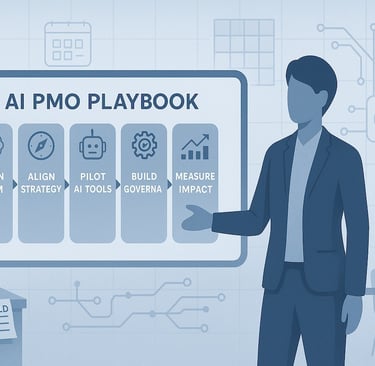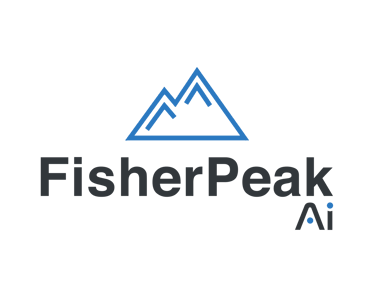The AI PMO Playbook: Building Your Roadmap to Organizational Adoption
Ready to bring AI into your PMO but not sure where to start? This playbook gives you the exact steps to train your team, build strategy, and launch AI with confidence.
AI IN PROJECT MANAGEMENT
Grant DeCecco
6/5/20253 min read


The AI PMO Playbook: Building Your Roadmap to Organizational Adoption
Over the last 20 years, I’ve worked with dozens of organizations as they navigated the messy middle of digital transformation. But I can tell you—nothing has disrupted how we manage projects, people, and priorities like AI is doing right now.
I’ve built programs, led enterprise PMOs, implemented project platforms, and restructured delivery teams. Today, I help organizations apply AI not just as a tool, but as a strategic capability. And I’ve seen firsthand: success doesn’t come from buying software. It comes from building a plan.
That’s where the AI PMO Playbook comes in.
What Is the AI PMO Playbook?
It’s a practical roadmap to help organizations integrate AI into their project and program management offices (PMOs) in a way that is measurable, responsible, and aligned with business value.
You don’t need to become an AI expert to start.
But you do need a strategy that combines three things:
AI training for your teams
AI strategy tied to business goals
AI implementation that’s auditable and compliant
Step 1: Start with Capability Building
If you’ve implemented tools like Microsoft Project or JIRA, you know tech only works if people understand how to use it. AI is no different.
Where I recommend starting:
Host short “AI in the PMO” lunch-and-learns
Train PMs on AI prompt engineering for reporting, risk assessments, and resource planning
Run pilot projects using AI to draft status reports, RAID logs, or risk mitigation plans
This is low-lift, high-return work.
A PM who learns to ask AI for “3 project risk scenarios based on resource trends and historical delivery rates” is already ahead of 90% of peers.
Step 2: Connect AI Strategy to Business Objectives
Most orgs jump straight to tools like Copilot or ChatGPT without asking: What business problem are we solving?
In one client engagement, their biggest issue was lack of enterprise visibility into resource capacity. We tackled this by:
Implementing OnePlan across project and operations teams
Integrating AI to model resource demand scenarios using historical and forecasted data
Training PMO leaders to simulate “what-if” project delivery options
The result?
They built a realistic enterprise delivery roadmap that updated in real time as project and operational needs shifted.
Step 3: Don’t Ignore Ethics and Compliance
This is non-negotiable.
AI introduces risk—bias in recommendations, legal liability for decisions, and serious data privacy issues.
I worked with HR leaders and legal advisors to co-author the AI Guide for HR, which outlines exactly what organizations need to watch for:
Conduct Privacy Impact Assessments for any AI tools that access employee or project data
Disclose when AI is used in decision-making, especially for hiring or promotions
Keep humans in the loop—AI should support decisions, not make them
One story that stuck with me: a Canadian airline’s chatbot gave false refund info. The court ruled the company—not the AI—was responsible. That precedent matters.
If you'd like a copy of the AI Guide for HR, send me a message.
Step 4: Focus on Measurable Outcomes
Ask yourself: What will success look like in 3 months?
Here’s what I track:
Reduced time spent on manual tasks like reporting or scheduling
Improved accuracy in forecasting project delays
Higher satisfaction scores from PMs and stakeholders using AI tools
One PM I worked with went from spending 6 hours a week manually building dashboards to 45 minutes using an AI-powered summary in Power BI.
That’s what success looks like.
Step 5: Build an AI Governance Model Early
Even if you’re just piloting tools, build the habit of good AI hygiene now.
Set clear rules:
What tools are approved?
What use cases are acceptable?
How do we audit outputs for bias or inaccuracy?
Give your team confidence by showing them you’re not throwing AI into the mix without oversight.
Your Call to Action
If you’re reading this, you’re already ahead of the curve. Most orgs are still in “wait and see” mode. Don’t be them.
Here’s how to move forward this month:
Identify one PMO process that could benefit from AI (reporting, resource forecasting, etc.)
Train 2–3 team members to pilot AI tools using structured prompts
Establish a draft AI usage policy using the framework from the AI Guide for HR
Track outcomes over 30 days
Then review. Refine. Scale.
AI isn’t the future. It’s the now. And your PMO is the perfect place to start.
You don’t need perfection—you need momentum.
Let’s build that roadmap together.
- Grant
